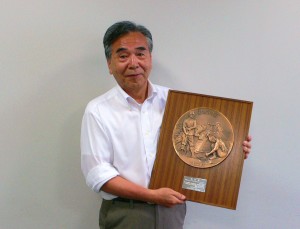Top>News> Outstanding Civil Engineering Achievement Award
 Index
Index
Outstanding Civil Engineering Achievement Award

The Research and Development Initiative, Fukuoka Unit (Unit Director: Shoji Fukuoka (Professor, Center for Research and Development Initiative) won the Outstanding Civil Engineering Achievement Award Group I as part of the 2014 Japan Society of Civil Engineers Awards presented at the society’s general assembly held on June 12, 2015.
Outstanding Civil Engineering Achievement Award Group I
This award recognizes revolutionary individual technology which, as part of a specific project, makes a significant contribute to the growth of civil engineering through planning, design, execution, maintenance, management and other aspects which are of obvious benefit to society. (In addition to tangible aspects, the prize also recognizes intangible aspects such as information, management, business models, implementation of systems, etc.)
Project Background
“New environmentally-friendly riverbank protection technology which realizes flood control for fast-flowing rivers” (construction of riverbank protection by utilizing an embankment sandbank with giant stones)
Ministry of Land, Infrastructure, Transport and Tourism; Hokuriku Regional Development Bureau
Ministry of Land, Infrastructure, Transport and Tourism; Hokuriku Regional Development Bureau, Toyama Office of Rivers and National Highway
Chuo University Research and Development Initiative, Fukuoka Unit
The fast-flowing area including Joganji River possesses great flood flow energy and an unstable water route. There is a high risk of dike break and flooding due to erosion and scouring of the riverbank. Therefore, the safety for riverbank erosion had been improved mainly by using concrete block revetments. However, this method causes a deep-channel flow path in front of the revetments. This results in the main flow of floodwater remaining close to the levee and heightens the risk that riverbank corrosion will reach the levee itself.
In response, our fieldwork was conducted at Joganji River. The fieldwork consisted of onsite testing and onsite implementation of test methods. The fieldwork clarified the riverbed fluctuation mechanism in rivers with small rocks, as well as the mechanism in which a deep-channel flow path is formed along the whole area of revetments. This enabled the development of “new environmentally-friendly riverbank protection technology which realizes flood control for fast-flowing rivers,” a riverbed protection technology which fully utilizes the natural properties and riverbed materials of fast-flowing rivers.
The construction method uses giant stones produced in the river channel. These giant stones are positioned at water colliding front at the edge of upper reach of a sandbank along the riverbank. The unified giant stones and sandbank acts like a continuous spur dike, altering the flow of water. This smoothly directs the floodwater current toward the middle of the river channel, thus protecting the riverbank from scouring and erosion. Additionally, scouring is reduced through working with the weight of giant stones positioned at the area. Water collides at the area in front of construction of riverbank protection. As such, the construction method protects and aids in recovery of the sandbank. Overall, this technology excels at utilizing natural properties. A summary paper has already been published featuring this new construction method.
The developed construction method is a new environmentally-friendly riverbank protection technology which realizes flood control for fast-flowing rivers. Furthermore, the method is capable of being applied to other rivers by utilizing a handbook. Accordingly, this construction method was honored with the Outstanding Civil Engineering Achievement Award in recognition of its contribution to the growth of civil engineering technology and the benefit of society as a whole.
Outstanding Civil Engineering Achievement Award, 2014 Japan Society of Civil Engineers Awards![]()
Chuo University Research and Development Initiative, Fukuoka Unit![]()
- Research Activities as a Member of Research Fellowship for Young Scientists (DC1), Japan Society for the Promotion of Science (JSPS) Shuma Tsurumi
- Important Factors for Innovation in Payment Services Nobuhiko Sugiura
- Beyond the Concepts of Fellow Citizens and Foreigners— To Achieve SDGs Goal 10 “Reduce Inequality Within and Among Countries” Rika Lee
- Diary of Struggles in Cambodia Fumie Fukuoka
- How Can We Measure Learning Ability?
—Analysis of a Competency Self-Assessment Questionnaire— Yu Saito / Yoko Neha - The Making of the Movie Kirakira Megane








